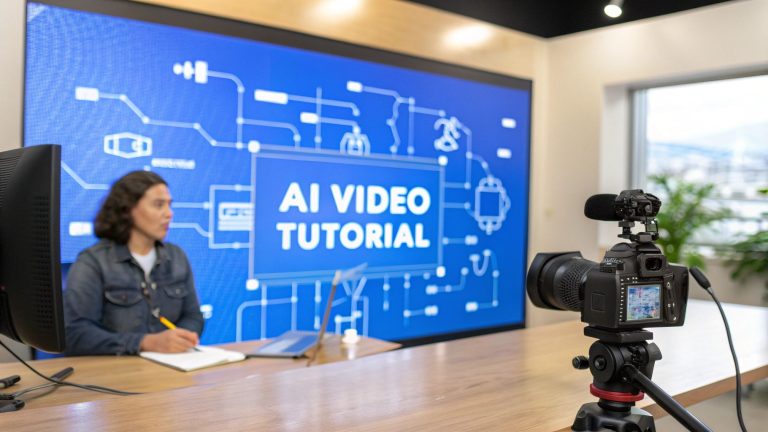So, you want to get into AI video creation? The whole process is about taking an idea, turning it into a script, and then letting AI tools generate the visuals and voiceover before you assemble the final product. It breaks down what used to be a complicated production process into straightforward, manageable steps.
The best part? You don't need a ton of technical skill or expensive gear. It’s really about guiding the AI to bring your creative vision to life.
Welcome to the New Era of Video Creation
If you've ever felt held back by the time, budget, or technical know-how needed for traditional video creation, you're not alone. The good news is that learning how to make AI videos completely changes the game. It levels the playing field for creators, marketers, and businesses of all sizes.
This technology demystifies the entire production process. What was once a complex and costly headache has become a streamlined workflow. You can forget about intimidating software and pricey camera equipment. Your starting point is now just a solid idea and a few clicks.
The Core AI Video Workflow
The fundamental process is surprisingly simple and intuitive. It all kicks off with your initial concept, which you'll flesh out into a script. From there, you just need to pick the right AI tools to bring your vision to life. This infographic breaks down the essential stages.
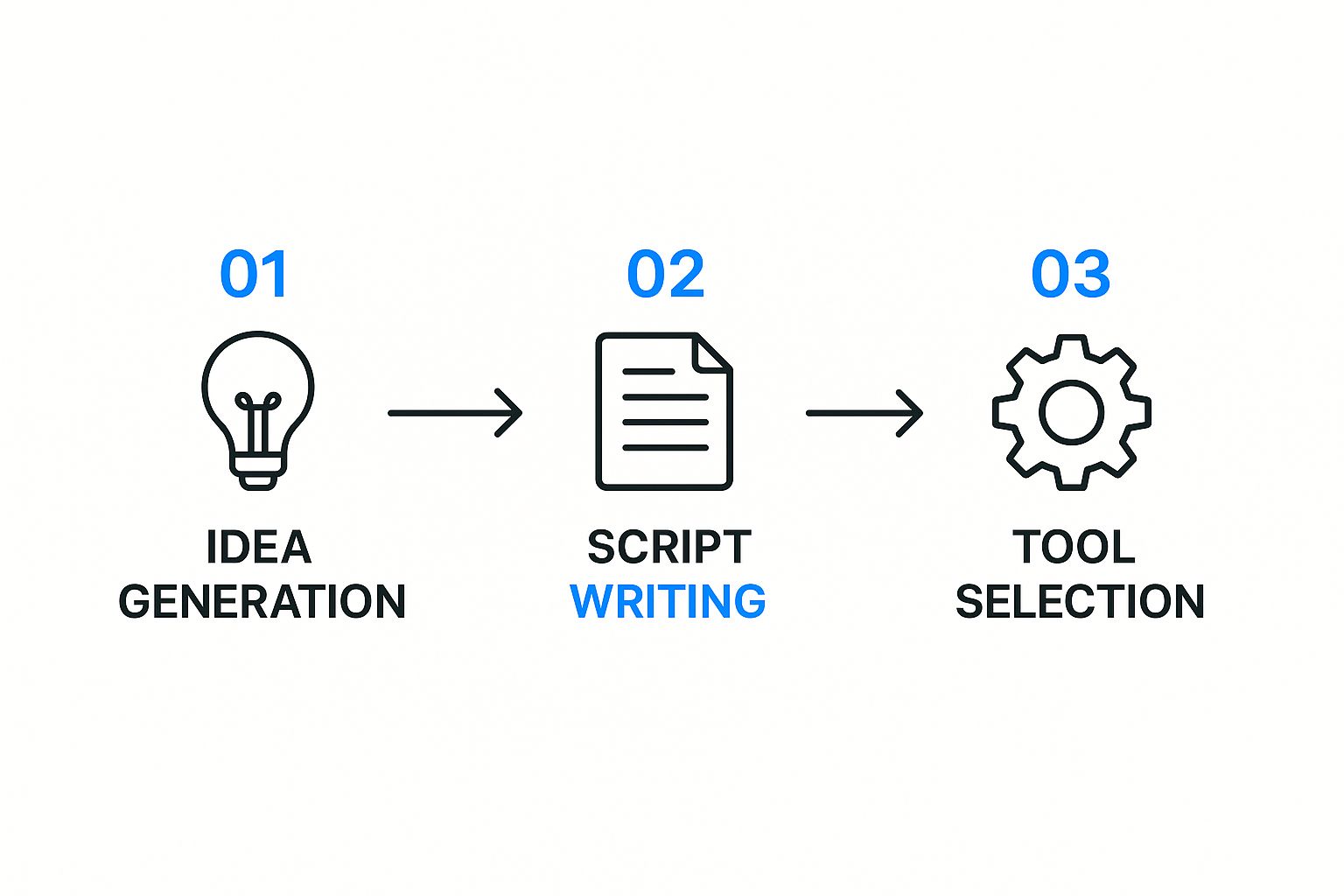
As you can see, a structured approach is key. Starting with a strong, clear idea provides the foundation for a successful AI-generated video, with each stage building directly on the last.
Let's quickly summarize the workflow in a table to see how it all fits together.
Core AI Video Generation Workflow at a Glance
This table outlines the fundamental stages involved in creating a video using AI tools, from the initial idea to the final edited piece.
| Stage | Key Action | AI's Role |
|---|---|---|
| 1. Idea & Concept | Brainstorm the video's core message and purpose. | Can help generate topic ideas or flesh out concepts. |
| 2. Scripting | Write a clear and concise script for narration. | Can generate or refine scripts based on your prompts. |
| 3. Generation | Select AI tools for visuals and voiceover. | Generates video clips, images, and a voiceover. |
| 4. Editing & Polish | Assemble assets, add music, and refine the final video. | Can assist with transitions, captioning, and final cuts. |
This flow shows that while AI does the heavy lifting, your input at each stage is what makes the video unique and effective.
The key takeaway is this: AI is a powerful collaborator, not a replacement for creativity. Your unique prompts, editing choices, and final review are what give the video its distinct personality and impact.
This shift isn't just a fleeting trend; it's a rapidly growing market. The generative AI video creation market was valued at $0.32 billion in 2024 and is on a steep upward trajectory. This growth underscores the increasing demand for faster, more cost-effective video content across all industries.
As you get deeper into making AI videos, understanding the broader AI applications in digital marketing can give you valuable context. Video is just one powerful piece of a much larger strategic puzzle where artificial intelligence is making a huge impact.
Crafting Your Script with AI Prompts
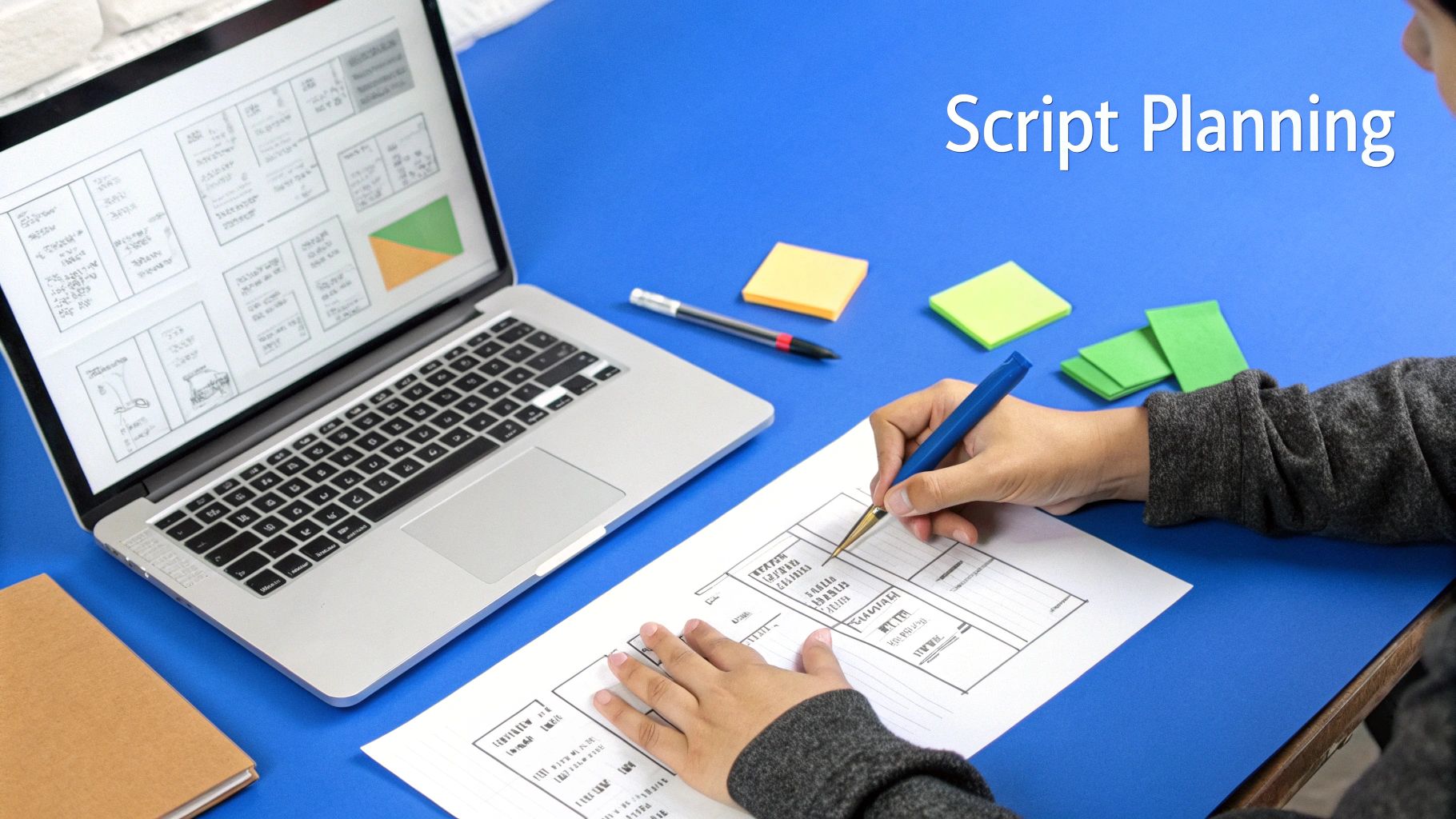
Every great video starts with a solid script, and this is where you step into the director's chair. When you’re making AI videos, your most powerful tool is the prompt you feed the AI. The quality of your script almost entirely hinges on the quality of your instructions.
Think of AI scriptwriting tools like ChatGPT or Jasper as incredibly smart but very literal assistants. They need crystal-clear direction to give you something you can actually use. A vague prompt like "write a script about marketing" is a recipe for a generic, forgettable video. You have to give the AI context and guardrails to guide it toward what you envision.
From Basic Prompt to Polished Script
To get a high-quality draft, your prompt needs to be specific. Forget simple requests. Instead, build a detailed instruction set that covers the core elements of your video. This is the heart of effective prompt engineering.
So, how do you structure a prompt that actually works?
- Define the Persona: Tell the AI who it should be. Something like, "Act as an expert social media strategist with 10 years of experience."
- Specify the Target Audience: Who are you talking to? "The audience is small business owners who are new to digital marketing."
- Set the Tone and Style: How should the video feel? "The tone should be encouraging and conversational, avoiding technical jargon."
- Outline the Structure: Give the AI a roadmap. "The video should be 60 seconds long and follow a hook-problem-solution-CTA structure."
This level of detail is a game-changer. It transforms the AI from a random text generator into a focused collaborator, giving it the necessary guardrails to create a script that aligns with your goals.
Key Insight: The best AI-generated scripts come from prompts that are rich with detail. Your job is to provide the AI with a clear blueprint of the final product you want to create.
Refining the AI-Generated Draft
Even with a perfect prompt, the AI's first draft is just that—a draft. The real magic comes from the human touch you bring in the review and refinement stage. This is your chance to inject your unique personality, check for accuracy, and make sure the story flows naturally.
For instance, an AI might spit out a line that’s technically correct but completely flat. Your job is to rewrite it to be more relatable or impactful. If the AI uses a statistic, double-check its source and make sure it’s still relevant. This refinement process is what turns a good AI script into a great one, creating content that feels authentic and trustworthy.
Turning Your Script Into an AI-Powered Video
Alright, you've got a polished script ready to go. Now for the fun part: making your words come alive with AI-generated visuals and audio. This is where the magic really happens, letting you craft an entire video without ever needing a camera or a microphone.
The sheer number of AI tools out there can feel like a lot to sort through, but they mostly boil down to a few main types. Getting a handle on what each one does best is the key to picking the right one for your project. To dig deeper, you can explore the best AI video and image creation tools to see what fits your workflow.
Choosing Your AI Video Generator
AI video generators typically fall into two camps: text-to-video and avatar-based. Each one has its own strengths and is built for different kinds of content.
-
Text-to-Video Generators: Tools like RunwayML or Luma Labs are fantastic for turning your script prompts into dynamic, cinematic scenes. They're my go-to for creating B-roll, artistic visuals, or any story that needs a dose of imagination. Think social media shorts or eye-catching marketing clips.
-
Avatar-Based Generators: Platforms such as Synthesia or HeyGen put a digital person on screen to deliver your script. This works incredibly well for corporate training, tutorials, or any presentation where a human touch helps connect with the audience. For many creators, this is also a brilliant way to create free faceless videos effortlessly, letting them build a personal brand without showing their face.
So, which one should you use? It really depends on your goal. If you’re making a viral TikTok about a wild historical fact, a text-to-video tool will give you that creative flair. But for a simple, no-fuss product tutorial, an avatar-based generator is probably the smarter, more direct choice.
To help you decide, here’s a quick comparison of some popular options on the market.
Comparing Popular AI Video Generation Tools
Choosing the right platform can make or break your project. This table breaks down some of the top players to give you a better sense of where to start.
| Tool | Best For | Key Feature | Pricing Model |
|---|---|---|---|
| RunwayML | Creative Storytelling & B-roll | Advanced text-to-video & video-to-video generation | Freemium & Subscription |
| Synthesia | Corporate & Training Videos | Realistic AI avatars and multi-language support | Subscription |
| HeyGen | Personalized Marketing & Sales | Customizable avatars and video templates | Freemium & Subscription |
| Luma Labs | High-Fidelity 3D & Cinematic Scenes | AI model "Dream Machine" for realistic video | Free (currently) |
| Pika Labs | Social Media & Short-Form Content | User-friendly interface and artistic style options | Freemium & Subscription |
Each of these tools has unique strengths. Your best bet is to try a few free or trial versions to see which one clicks with your creative vision and workflow.
Nailing the Look and Sound
Once you've picked your tool, the real work begins. The biggest challenge I see people face is keeping the visuals consistent from one scene to the next.
The trick is to be super specific and repetitive with your prompts. If your main character is "a detective in a trench coat in a rainy 1940s city," you need to hammer those details home in every single prompt to maintain a cohesive look.
While you're generating visuals, you'll also need a voiceover. Modern AI voice generators from platforms like ElevenLabs are honestly mind-blowing. They offer an incredible variety of voices, accents, and emotional inflections.
Pro Tip: Don't just settle for the default voice. I always test at least three or four different AI voices using a key sentence from my script. You're listening for the one that perfectly captures the personality of your brand—is it confident, warm, or high-energy?
The adoption of these tools is exploding. A recent study shows that 41% of brands plan to use AI for video creation in 2025. That’s a huge leap from just 18% in 2024, as more businesses pull AI into their production workflows. This rapid growth just goes to show how accessible and powerful this technology has become.
Polishing Your Video for a Professional Finish
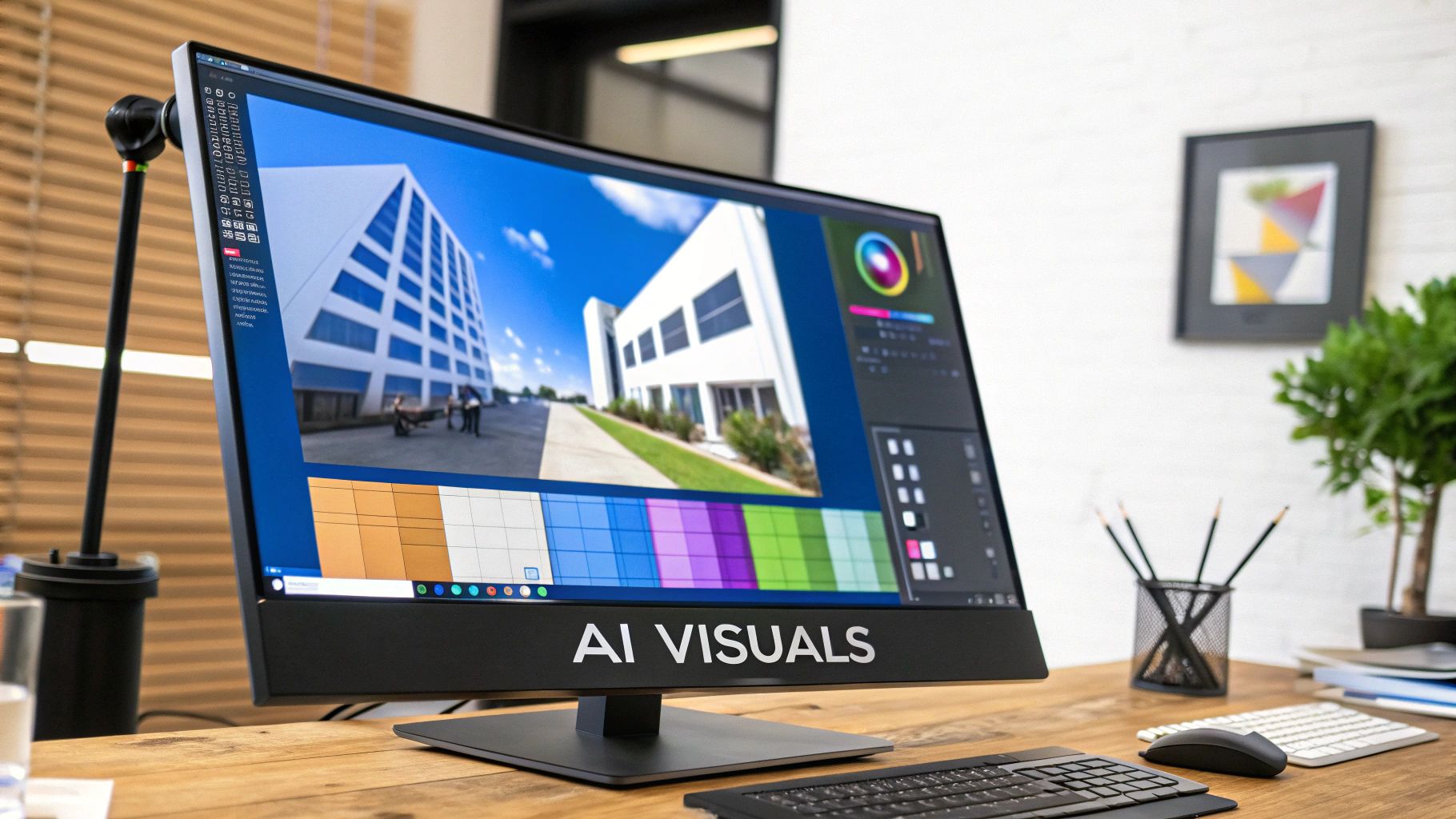
The AI has done the heavy lifting, giving you the raw visuals and a voiceover. Now, it's your turn to step in as the editor. This is where the magic really happens—transforming a bunch of AI-generated clips into a polished, professional video that actually stops people from scrolling.
First things first, you need to assemble your raw materials. Most AI video platforms like ShortsNinja come with a built-in timeline editor, but you can always export the clips and use simple desktop software like CapCut or iMovie. The goal here is to arrange your clips into a sequence that lines up with your script.
This is all about pacing. Drag your clips onto the timeline, then play the AI voiceover. You'll want to trim or extend each visual so the scene changes land perfectly with the narration. When the visuals and the voiceover are in sync, the whole video just feels right.
Adding Layers of Sound and Style
With your visuals and voiceover locked in, it's time to bring in the audio. Background music is an absolute must; it’s what sets the emotional tone for your entire video. Pick something that matches the vibe—upbeat and energetic for a marketing video, or calm and focused for a tutorial.
Next up, sound effects (SFX). A subtle "whoosh" when you transition between scenes or a quick "ding" to highlight a key point can make your video feel so much more dynamic. These little audio cues give your content a professional sheen that audiences pick up on, even if they don't consciously realize it.
My Personal Tip: Pour some extra effort into the first five seconds. I always add a punchy sound effect and make sure my most interesting visual is right at the start. That initial hook is your best shot at grabbing someone's attention before they swipe away.
Once the sound is dialed in, let's talk branding. Consistently using your brand elements is how you build recognition over time.
- Add Your Logo: Place a small, semi-transparent version of your logo in one of the corners.
- Use Brand Colors: If you're adding text overlays or title cards, make sure they stick to your brand’s color palette.
- Choose a Consistent Font: Pick a font for your captions and on-screen text that reflects your brand’s personality.
These small, consistent touches are vital when you're learning how to make AI videos that don't just look good, but also build a memorable brand identity.
The Final Polish
The last thing to do is a final review. Watch your video from beginning to end, preferably on the same kind of device your audience will be using, like a smartphone. Look for any awkward transitions, weird jumps in audio levels, or any visual glitches.
AI generation can sometimes throw up strange artifacts or camera movements, especially if you've asked for unusual angles. Don't hesitate to regenerate a clip that looks off or just cut it out completely if it isn't working. Your human eye is the final quality check that AI simply can't match yet. It's these finishing touches that separate a basic AI creation from a genuinely impressive piece of content.
Automating Your Publishing Workflow
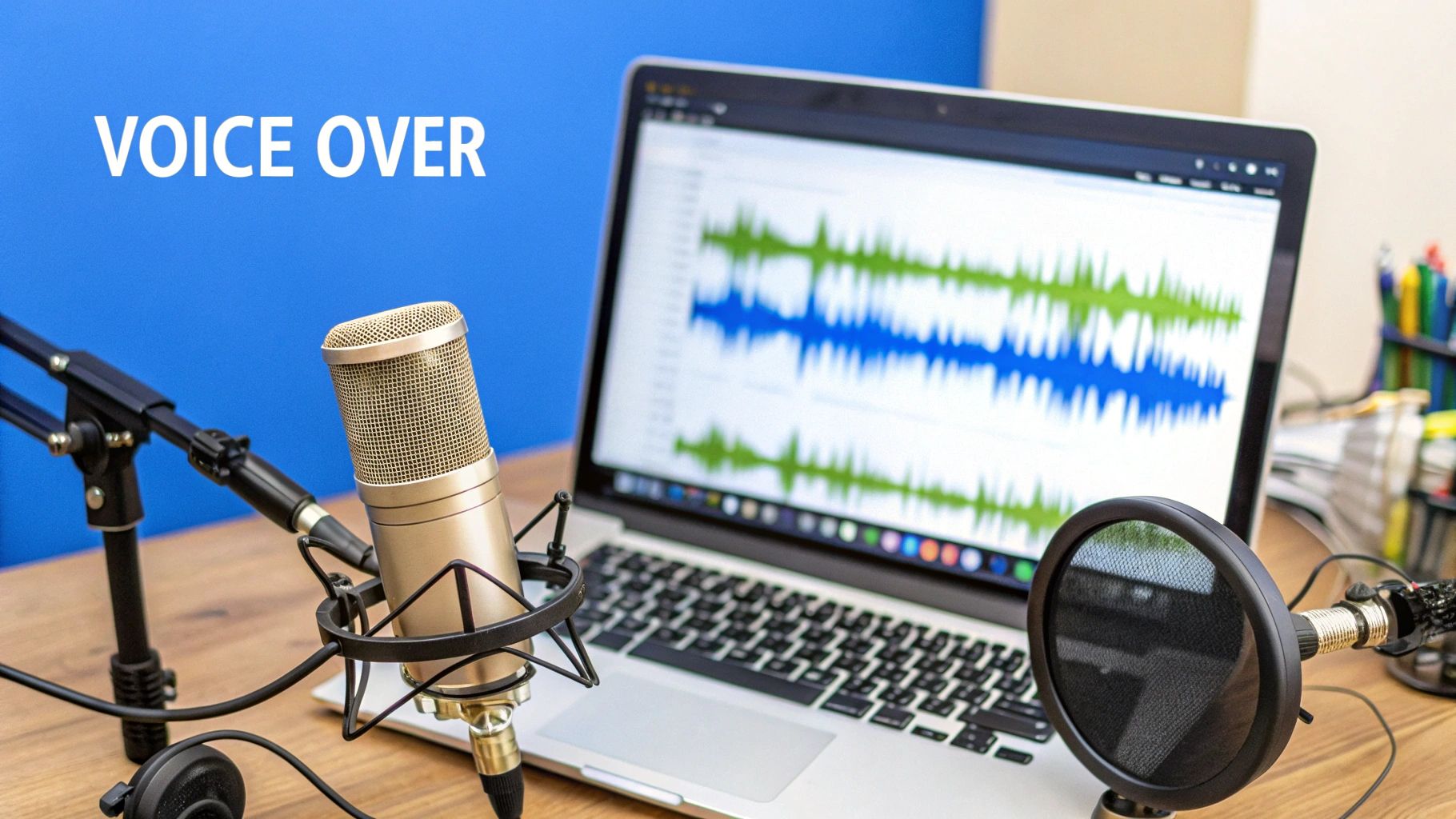
So, you’ve created a killer AI video. That’s a huge win, but it’s really only half the battle. The real magic happens when you get that content in front of the right audience, and a smart publishing workflow is your secret weapon here. This is where automation platforms like ShortsNinja completely change the game.
That screenshot above shows a clean, centralized dashboard—the heart of any good automation system. Instead of jumping between a half-dozen different apps, you get one single hub to manage everything from. It's a lifesaver.
Get Your Social Media Presence on Autopilot
Let’s be honest, manually uploading the same video to YouTube Shorts, TikTok, and Instagram Reels is a soul-crushing time-sink. An automated workflow takes that repetitive grind and boils it down to one quick, efficient action. You just connect your social accounts once, map out a content calendar, and let the system do the heavy lifting.
This simple shift frees you up to focus on what actually matters: dreaming up your next great video. You’re no longer stuck in the weeds of administrative tasks. Instead, you're building a content engine that works for you, even when you’re offline. And once your AI video is ready to go, mastering YouTube SEO tips becomes the next critical step to make sure your hard work actually gets seen.
Key Takeaway: Automation isn’t just about clawing back a few hours. It’s about maintaining a consistent posting schedule, which is a massive signal to social media algorithms. Posting regularly tells them you're an active, reliable creator, which helps boost your visibility and reach.
Building Your "Set It and Forget It" Workflow
Getting started with a platform like ShortsNinja is surprisingly straightforward. The whole idea is to create a system for your content distribution that you can essentially set and forget.
Here’s the basic playbook:
- Connect Your Accounts: First, you’ll securely link your YouTube, TikTok, and Instagram profiles to the dashboard. This is a one-and-done setup that gives the platform permission to post for you.
- Upload Your Content: Next, you add your finished AI-generated videos into a central content library right inside the platform.
- Build Your Schedule: This is where the magic happens. You create a posting calendar, scheduling videos to go live on specific days and at specific times to catch your audience when they're most active. For a deeper dive, check out our guide on other powerful ways to automate your video content creation.
This process completely transforms how you manage your channels. What used to be a daily chore becomes a strategic, automated operation. This kind of efficiency is a huge reason why generative AI is reshaping video production. In fact, roughly 30% of all digital video ads are now created or touched up with these technologies. What’s really interesting is that smaller and mid-sized brands are adopting these tools even faster than the big corporations, giving them a serious competitive edge with lower costs and faster turnarounds.
Of course. As you start exploring AI-assisted video production, it's totally normal for questions and a bit of uncertainty to creep in. This is new territory for everyone, from total beginners to seasoned pros, and we're all figuring out the best ways to use these tools. Let's tackle some of the most common concerns so you can dive in and start creating with confidence.
Jumping into how to make AI videos might seem intimidating, but the learning curve is surprisingly gentle. The real trick is to stop thinking of AI as a magic button and start seeing it as a powerful assistant that you get to direct.
Can AI Videos Truly Be Unique and Creative?
Yes, absolutely. While the AI is generating the raw visuals and voiceover, you are always the creative director. Your unique vision is what makes the final product special—it comes through in your initial idea, the specific prompts you write, and the editing choices you make at the end. The real creativity is in how you curate and guide the process.
Think of it like this: the AI is your camera crew, your voice actor, and your special effects team all rolled into one, but you're the one in the director's chair calling all the shots.
The way you piece together different scenes, choose a particular voice, layer in your branding, and select the perfect background music all come together to create a video that is distinctly yours. No two creators will end up with the same video because no two creative visions are identical.
The output is a direct reflection of your input and oversight. An AI tool can generate a clip, but only you can weave it into a compelling story that connects with your audience.
This is the human touch that transforms a collection of AI-generated assets into something cohesive and engaging.
What Are the Biggest Mistakes to Avoid?
When you're first learning how to make AI videos, it's pretty easy to fall into a few common traps. Just being aware of them from the get-go can save you a ton of frustration and help you create much better content, faster.
Here are the biggest mistakes I see people make:
- Relying 100% on the AI's first draft. This is a surefire way to get generic, soulless content. Human review and refinement are absolutely essential for quality.
- Skipping post-production. Adding music, sound effects, and your branding is what elevates a video from feeling sterile and robotic to polished and professional.
- Using inconsistent visuals. If your video jumps between drastically different art styles, it can be really jarring and confusing for the viewer. Aim for a cohesive look and feel.
- Neglecting the script. A weak script means a weak foundation. It doesn't matter how stunning the AI visuals are if the message is muddled or boring.
Steering clear of these pitfalls is a huge part of making videos that not only look good but actually perform well.
How Much Does It Cost to Get Started?
Honestly, it costs a tiny fraction of what traditional video production would set you back. Hiring a videographer, editor, and voice actor can easily run into thousands of dollars for a single video. AI tools are way more accessible.
Most of the top platforms use a subscription model, with plans typically ranging from $20 to $100 per month. The price usually depends on the features you need and how many videos you want to create. Many even offer free trials or a handful of credits to let you experiment and get a feel for the workflow before you commit any cash.
For most creators and small businesses, a modest monthly subscription is all it takes to unlock a powerful video creation suite. This is a game-changer because it dramatically lowers your production overhead, which has a direct impact on how AI boosts video monetization.
Are There Copyright Issues with AI Content?
This is a hot topic and the legal side of things is still evolving, but you can navigate it safely. The good news is that reputable AI video platforms almost always build their models using licensed or royalty-free stock assets. This means that, in most cases, you have full commercial rights to use the videos you create.
However, and this is important: you absolutely must read the terms of service for any tool you use. The platform's policy will clearly spell out what you can and can't do with the content. To stay on the safe side, stick with established, well-known platforms and always double-check their policies before you publish, especially if it's for a commercial project. A little due diligence here goes a long way in protecting your work.
Ready to stop worrying and start creating? ShortsNinja gives you the tools to script, generate, and schedule stunning AI videos in minutes, not hours. Start your free trial and claim your 30% lifetime discount with code NINJA30 today!

